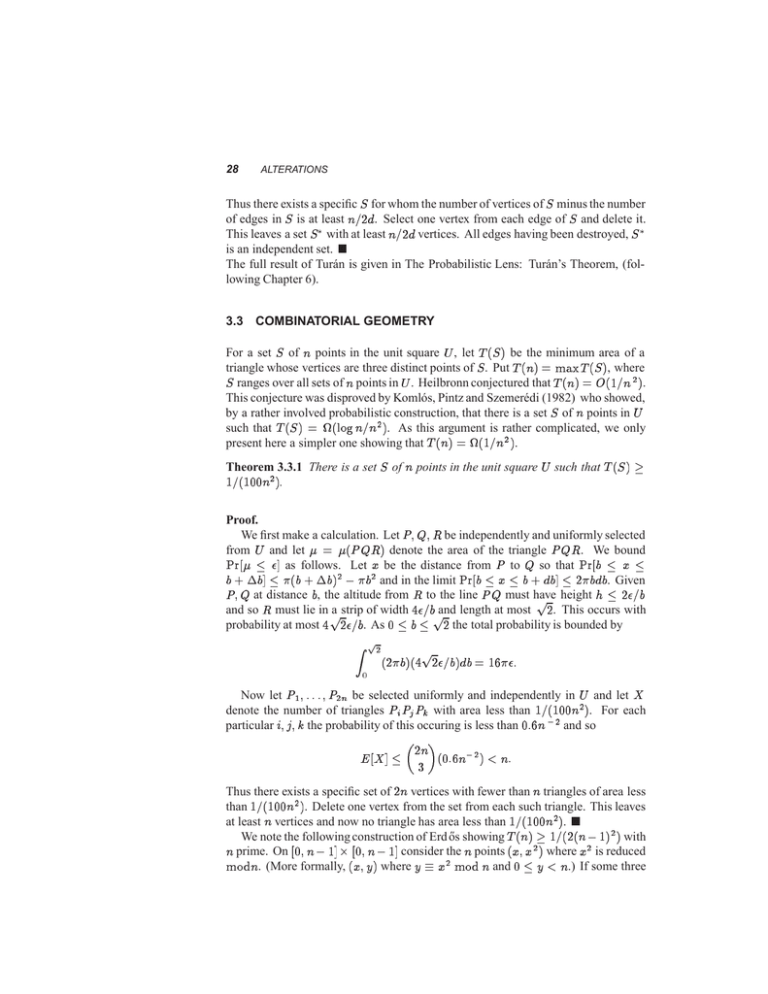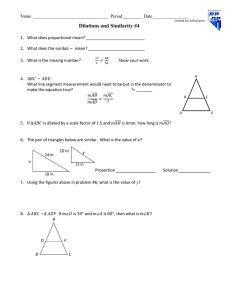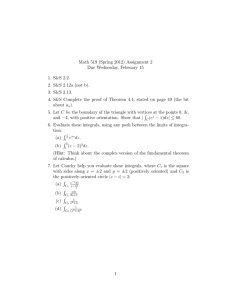sec. 3.3, pp. 28-29
advertisement

28 ALTERATIONS Thus there exists a specific for whom the number of vertices of minus the number of edges in is at least !" #. Select one vertex from each edge of and delete it. This leaves a set with at least !" # vertices. All edges having been destroyed, is an independent set. The full result of Turán is given in The Probabilistic Lens: Turán’s Theorem, (following Chapter 6). 3.3 COMBINATORIAL GEOMETRY For a set of ! points in the unit square $ , let % ! " be the minimum area of a triangle whose vertices are three distinct points of . Put % !!" # $%& % ! ", where ranges over all sets of ! points in $ . Heilbronn conjectured that % !!" # &!'"! ". This conjecture was disproved by Komlós, Pintz and Szemerédi (1982) who showed, by a rather involved probabilistic construction, that there is a set of ! points in $ such that % ! " # (!)*+ !"! ". As this argument is rather complicated, we only present here a simpler one showing that % !!" # (!'"! ". Theorem 3.3.1 There is a set '"!',,! ". of ! points in the unit square $ such that % ! " Proof. We first make a calculation. Let '( )( * be independently and uniformly selected from $ and let + # +!' )*" denote the area of the triangle ' )*. We bound -./+ ! ,℄ as follows. Let - be the distance from ' to ) so that -./. ! - ! . 1 2.℄ ! /!. 1 2." " /. and in the limit -./. ! - ! . 1 #.℄ ! /.#.. Given '( ) at distance ., the altitude from * to the line ' ) must have # height 0 ! ,". and so * must lie in # a strip of width 3,".#and length at most . This occurs with probability at most 3 ,".. As , ! . ! the total probability is bounded by ! ! ! /."!3 # ,"."#. # '4/,1 Now let '" ( 1 1 1( ' be selected uniformly and independently in $ and let 2 denote the number of triangles ' ! '" '# with area less than '"!',,! ". For each particular 3( 4( 5 the probability of this occuring is less than ,14! " and so 6 /2 ℄ ! ! " ! 5 !,14!" " 7 !1 Thus there exists a specific set of ! vertices with fewer than ! triangles of area less than '"!',,! ". Delete one vertex from the set from each such triangle. This leaves at least ! vertices and now no triangle has area less than '"!',,! ". We note the following construction of Erd 6 os showing % !!" '"! !! " '" " with ! prime. On /,( ! " '℄ $ /,( ! " '℄ consider the ! points !-( - " where - is reduced $*7!. (More formally, !-( 8" where 8 % - $*7 ! and , ! 8 7 !.) If some three PACKING 29 !" ! # and ! would be points of this set were collinear they would line on a line a rational number with denominator less than $. But then in % the parabola " would intersect the line !" ! # in three points, so that the quadratic " !" # would have three distinct roots, an impossibility. Triangles between lattice points in the plane have as their areas either halfintegers or integers, hence the areas must be at least "&#. Contracting the plane by an $ " factor in both coordinates gives the desired set. While this gem does better than Theorem 3.3.1 it does not lead to the improvements of Komlós, Pintz and Szemerédi. 3.4 PACKING Let ' be a bounded measurable subset of (! and let ) $"% denote the cube &'* "℄! of side ". A packing of ' into ) $"% is a family of mutually disjoint copies of ' , all lying inside ) $"%. Let + $"% denote the largest size of such a family. The packing constant Æ Æ $' % is defined by $ % ")*+! + $"%""! * $ % Æ ' -' where -$' % is the measure of ' . This is the maximal proportion of space that may be packed by copies of ' . (This limit can be proven always to exist but even without that result the following result holds with )*+ replaced by )*+ *,-.) Theorem 3.4.1 Let ' be bounded, convex, and centrally symmetric around the origin. Then Æ $' % ! #"!"! . Proof. Let /* 0 be selected independently and uniformly from ) $"% and consider the event $' ! / % " $' ! 0% # $. For this to occur we must have, for some !* % ' / 0 ! # ! # % #' by central symmetry and convexity. The event / -$#' %""! for each given 0 hence % 0 ! #' has probability at most ./&$' ! / % " $' ! 0% # $℄ & -$#' %""! #! ""! -$' %. Now let /!* . . . * / be selected independently and uniformly from ) $"% and let 2 be the number of 3 4 5 with $' ! / # %"$' ! /$ % # $. From linearity of expectation & ℄ & $# #! ""! -$' %. 62 Hence there exists a specific choice of $ points with fewer than that many intersecting copies of ' . For each /#* /$ with $' ! /#% " $' ! /$ % # $ remove either /# or /$ from the set. This leaves at least $ #! ""! -$' % nonintersecting copies of ' . Set


